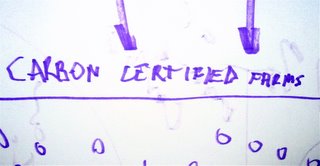
We started this blog as a way to share our thinking with our 'classmates' in the spirit of bouncing ideas off each other to help everyone have more creative ideas. So far we've bounced our early ideas (in the "Idols" post) and come up with a big idea, the Carbon Coalition. But the latter - while it has the potential to meet all the Catchment Management Authority's goals for ground cover and salination and species diversity and soil structure and community enhancement and water usage at point of landing and on and on - it's not a "farm system". In fact, it could easily be dismissed as just spin if you didn't understand it's potential to transform the face of the landscape forever, right across the nation, by harnessing as it does the profit motive to the cause of ecosystem regeneration.
But we must play the cards we are being handed. We need a "farm system", a whole of farm plan that is innovative (defined by the CMA as 'never been done before' - a big ask), replicable on other farms, can have a catchment-wide impact, positively impacts the triple bottom line, and meets the CMA's goals and objectives.

We said in our original submission for this program that we are "soil farmers" because the soil is the beginning and the end of it all. At Mass today Fr Frawley crossed our foreheads with damped ashes in a short ceremony (that usually takes place on Ash Wednesday, last week, but out here we couldn't get to town for it, so he did it on the First Sunday of Lent). The traditional words that the priest says when placing the cross on our foreheads are: "Remember man that thou art dust and unto dust thou shalt return." Adam was made from a lump of clay. Man came from the soil. And we all end up back there, pushing up daisies.

So "soil" stood out like the proverbial. Christine Jones has taught us the key indicator of soil health is carbon. So to be soil farmers we have to become carbon farmers.
Now growers are normally in the primary production business to grow commodities for sale on an open market. But once sequestering carbon in soils becomes and financial reality, the projected figures are so high (even when we halve them and halve them again) that production of produce could become secondary to the sequestering of carbon.
So we'll make the switch: our total farm plan will be based on sequestration.
 Our KPI will be the percentage of carbon in our soils and the maintenance and improvement in those levels. We'll endeavour to become a Carbon Farm Learning Centre for our distirct which will bring in further revenue as agriculturalists and ordinary people come to visit and stay are learn about soil carbon and the paradigms of agriculture generally. Other farmers can decide, after taking a look at our place or any of the other district learning centres, whether they too will become Carbon Certified for sequestration. Another enterprise we could possibly launch on the back of carbon farming is mapping annd testing soils for carbon. Daniel and Olivia (his soil scientist girlfriend) have identified a mehodology that appears robust and reliable. We have some commercial-in-confidence concepts surrounding the testing issue, so I can't tell you the full story. Let it be said that we have a national network fo testing laboratories in mind.
Our KPI will be the percentage of carbon in our soils and the maintenance and improvement in those levels. We'll endeavour to become a Carbon Farm Learning Centre for our distirct which will bring in further revenue as agriculturalists and ordinary people come to visit and stay are learn about soil carbon and the paradigms of agriculture generally. Other farmers can decide, after taking a look at our place or any of the other district learning centres, whether they too will become Carbon Certified for sequestration. Another enterprise we could possibly launch on the back of carbon farming is mapping annd testing soils for carbon. Daniel and Olivia (his soil scientist girlfriend) have identified a mehodology that appears robust and reliable. We have some commercial-in-confidence concepts surrounding the testing issue, so I can't tell you the full story. Let it be said that we have a national network fo testing laboratories in mind.And what does a Carbon Farm look like? There will be many variations. For instance, the US teams studying terrestrial sequestration are looking at wetlands. Some farms have them, some don't. But common carbon farming techniques are those which encourage 100% ground cover 100% of the time, and encourage deep-rooted perennials to enrich the soil. Techniques wwhich can be applied include rotational, time-controlled grazing, pasture cropping or advanced sowing, zero tillage cropping, permaculture, biodynamics, mulching, biosolids, nutrihumus, and stress free stock handling. There will be wildlife corridors to increase diversity of bird and small mammal life. And the entire enterprise will be planned as a biotic whole. As a Learning Centre the property will need meeting rooms and accommodation so more than the odd field day can be held. (There will be grades of Learning Centres.) The plan will accommodate Indigenous people's aspirations and the local community, with the value-added farmstay generating local employment.
SO that's it so far. We have the rest of March, April and most of May to refine our plan and nail it or chuck the lot away and start again.




No comments:
Post a Comment